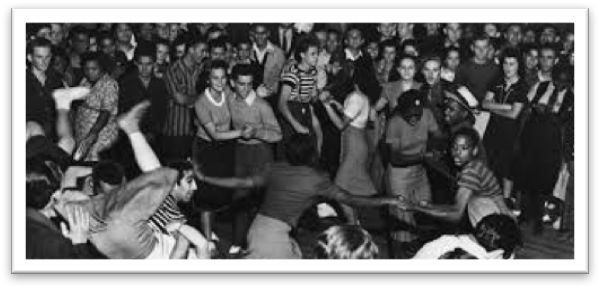Dance Age
Drawn to dance through an affinity for original Blues, Big Band Swing and Jazz music, the style I sought out was a dynamic and fun partnered social dance, named Lindy Hop circa 1927. Born of expressive talents, this form of Swing dance continued to evolve in America throughout the ’30s and ’40s, as the dancers and musicians developed their genres through a mutually reactive relationship. Amidst deep social and economic depression, these improvised styles had hearts and feet skipping to the after beat, smiles beamed and dance floors overflowed.
Partnered dance styles were superseded in the 1960’s by individualised freestyle dance forms, as rock and pop music took over, while both the USA and the UK experienced dramatic cultural and social change. During the late 1980’s vintage style social dancing saw the beginning of a resurgence and now as we head towards the twenties, almost a century on, Swing Dance is quickly returning as a well loved, popular pastime, internationally and across generations. Remarkably, some of the original dancers were still dancing and able to guide and teach the new generation of dancers. Frankie Manning for example, who was hugely influential and whose legacy continues to be, was an active figure in Lindy Hop until he passed away aged 94 in 2009 and Norma Miller, ‘Queen of Swing’, another of the famed original ‘Whitey’s Lindy Hoppers’, is still involved now at 96 years old.
For the most part, the present day older generation, some of whom we’re lucky enough to experience Swing dance the first time around, now live longer and are a larger proportion of the population than their predecessors. Social isolation has become a growing issue though and one of the most pressing and feared challenges that face elderly people and their families is Dementia. To understand the causes and discover ways of preventing and treating Dementia, many studies have taken place into the types and level of deterioration we experience as we age. Various factors; genes, diet, physical, mental and social activity, etc. have been scrutinised and theories tested. A 21-year study* of subjects aged 75 or over, looked at mental acuity in aging by monitoring rates of dementia, including Alzheimer’s disease. Quoting directly from, ‘Use It or Lose It: Dancing Makes You Smarter’, by Richard Powers, “The study wanted to see if any physical or cognitive recreational activities influenced mental acuity. They discovered that some activities had a significant beneficial effect…
…The only physical activity to offer protection against dementia was frequent dancing.
- Reading – 35% reduced risk of dementia
- Bicycling and swimming – 0%
- Doing crossword puzzles at least four days a week – 47%
- Playing golf – 0%
- Dancing frequently – 76%. That was the greatest risk reduction of any activity studied, cognitive or physical.”
* (Albert Einstein College of Medicine, New York City, published by the New England Journal of Medicine and funded by the National Institute on Aging)
Although not nearly old age, 30 is relatively late to start learning to dance, my mind was slower in interpreting information and the body more hesitant than the university students I later taught, but as I laughed my way through beginner Lindy Hop classes I learned through practicing movements and technique to improve my coordination and balance, to translate musical rhythms into movement, to react very quickly to subtle changes in pressure and movement, to understand how posture, tension and energy affect our ability to move in certain ways, and to rewire my brain to essentially work in a way I had never asked it to before.
Besides the excitement of learning something so enjoyably active, physically, the social interaction is also quite intensive. Rarely does one meet so many new and varied people at once, with whom one physically connects, sharing non-sexualised enjoyment on a regular basis. Lindy Hop tea dance social events bring people together through the joys of music, tea, cake and dancing. Generally, there’s a real sense of comradery. It literally changed my entire social network almost instantly, for socially isolated people and anyone suffering any form of depression, this could be a real lifeline.
Being an involved and active part of something so alive with history has helped me to feel connected with the past, made me more conscious of the passing of time, of evolution, of aging. It has given me a stronger sense of what community actually was, what it can be and a desire to encourage and support that, for everyone. There is comfort to be found in the research regarding aging and activity that repeatedly points to dance and social dance, as having a notably positive influence in preventing and slowing progress of Dementia, including Alzheimer’s and other degenerative disorders such as Parkinson’s disease also.
Following different studies, two particularly notable articles from ‘Frontiers in Aging Neuroscience’, express high levels of confidence in the benefits of dance. The articles note, “… maintaining a regular schedule of dancing into old age can preserve cognitive, motor and perceptual abilities and prevent them from degradation. We conclude that the far-reaching beneficial effects found in the group make dance, beyond its ability to facilitate balance and posture, a prime candidate for the preservation of everyday life competence of elderly individuals.”(Jan-Christoph Kattenstroth,1 Izabella Kolankowska,1 Tobias Kalisch,2 and Hubert R. Dinse1 ) and secondly, “… beneficial effects were found for dance-related parameters, such as posture and reaction times, but also for cognitive, tactile, motor performance, and subjective well-being… Our findings corroborate previous observations that dancing evokes widespread positive effects.” (Kattenstroth JC1, Kalisch T, Holt S, Tegenthoff M, Dinse HR.)
If you already dance, keep dancing. If you don’t dance, start, even if from a chair. Music, movement and interaction are uplifting. Music moves you, people can help motivate you and challenge you, to keep you on your toes. Movement helps you to keep on moving, it helps your mind to keep moving. If your body really won’t allow it, age won’t permit it, come to a social dance event anyway, sit and talk about the time you got thrown off a dance floor for flashing too much leg or doing a banned aerial, have a cup of tea and some cake, meet some strangers, make some friends and smile at the new Swing kids bringing a bit of history back to life and hopefully creating a better future for their older selves.
The dance age is now.




